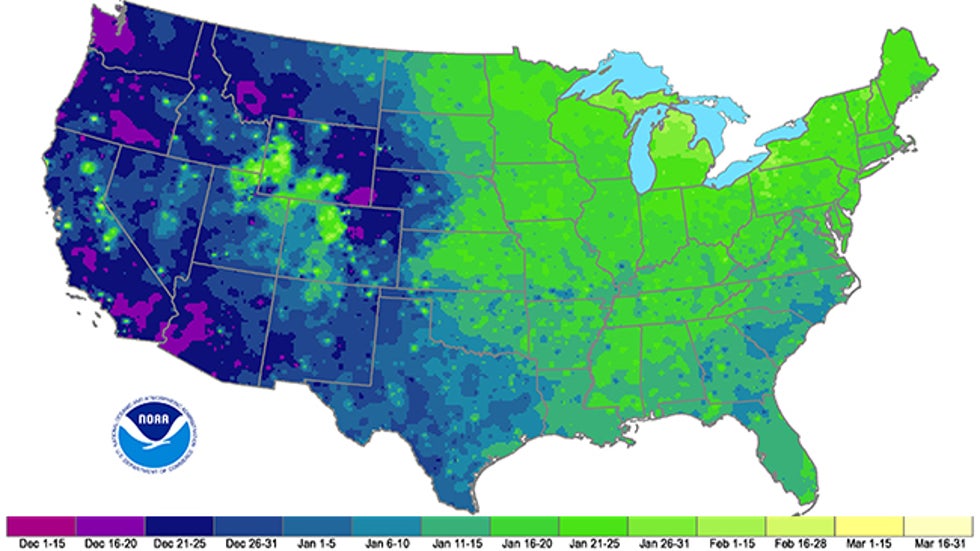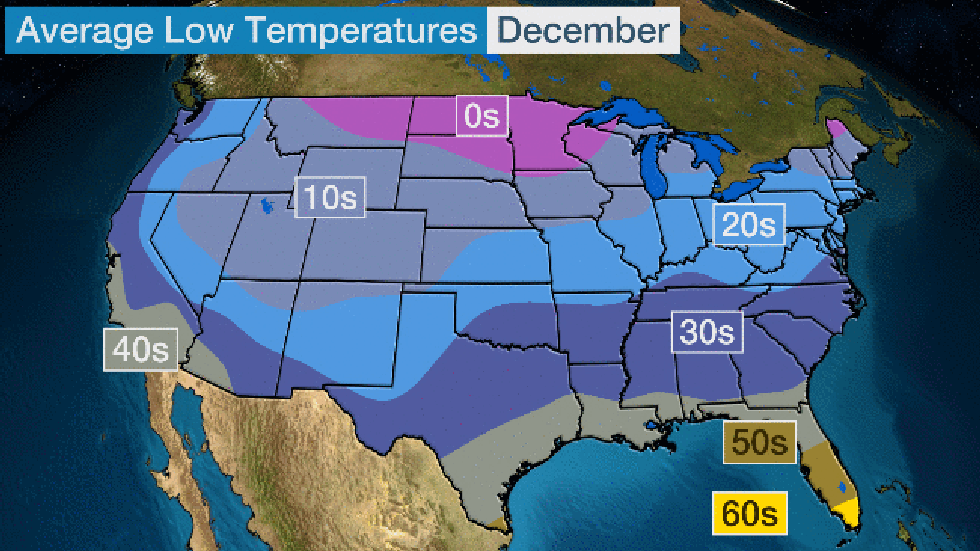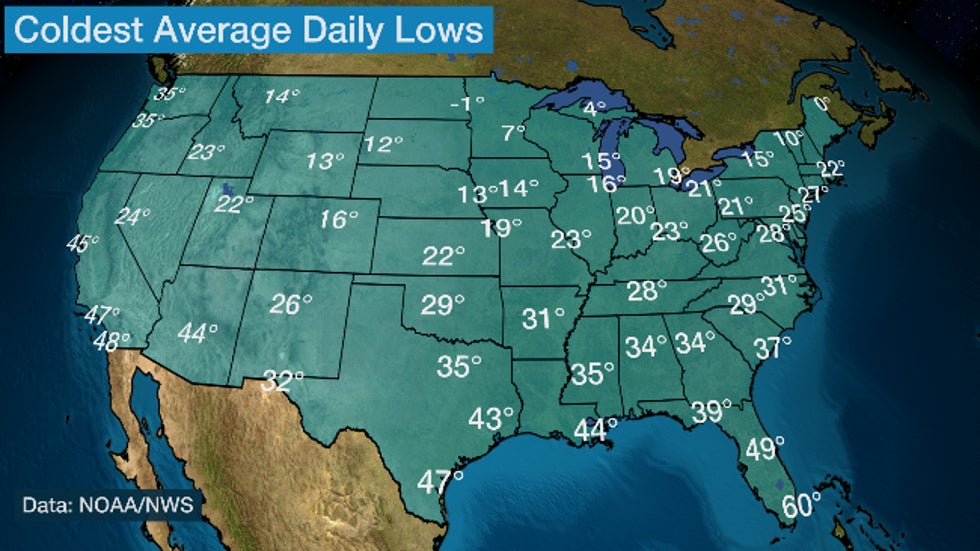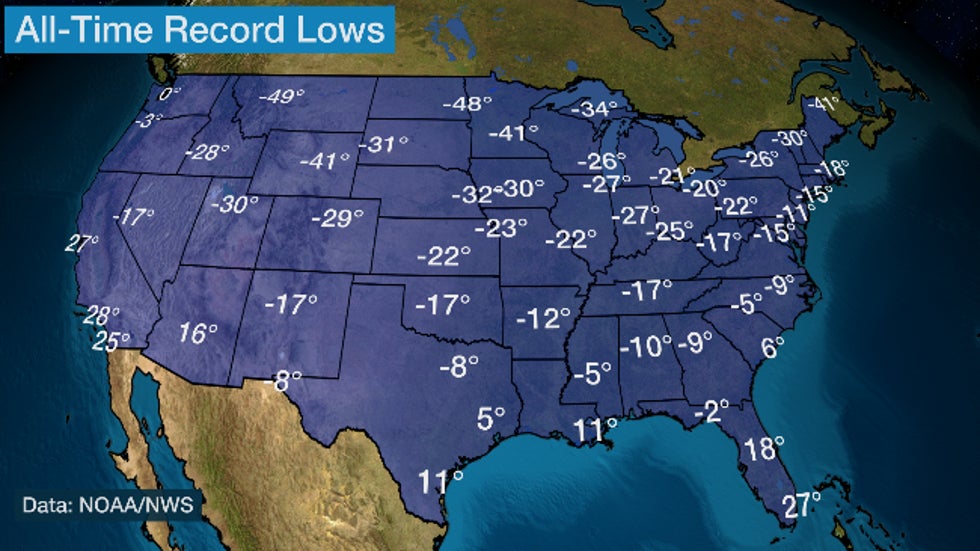Chris Dolce and Jonathan ErdmanPublished: January 21, 2020
Now is typically the coldest time of the year for most in the Northeast and Midwest, but history has shown it has been much colder in other winter months.
NOAA's National Centers for Environmental Information (NCEI) produced maps illustrating when the coldest day of the year, on average, occurs across the United States.

The eastern half of the country, as well as the higher elevations of the Rocky Mountains, typically have the coldest weather of the year in mid to late January.
Pockets of the Pacific Northwest, Southern California and southwestern Arizona are usually coldest in mid-December.
You can see how the average low temperatures evolve across the Lower 48 states from December through February in the animation below.

The reason for this temporal discrepancy is due to the increased snow cover in the East, as well as in the Rockies. Increased snow cover reflects sunlight and keeps ground temperatures colder.

In Alaska, the coldest time of year is usually in mid to late January for much of the state, with the exception of locations north of the Arctic Circle, where the coldest time tends to occur in February or during the first half of March.
In Hawaii, much of the island chain experiences the coldest day, relatively speaking, in early February. The island of Lanai, west of Maui, experiences its coldest day during the first two weeks of January.

These maps are not giving an actual forecast, but rather show the average date for the coldest day of the year. They are derived from NCEI's 1981-2010 U.S. climate normals, a dataset that consists of the 30-year average of certain climatological variables, including average daily high and low temperatures, for various cities throughout the U.S.
Because the map is showing an average and not a forecast, the actual coldest day of the year for your area may occur before or after the timeframe illustrated in the graphic.
In fact, for most places in North America, the day of the year when the coldest temperature occurs is typically a week or more later than the coldest average-low temperature, according to Dr. Brian Brettschneider, a climatologist with the University of Alaska Fairbanks.
The coldest temperatures of the year usually occur when bitterly cold arctic air in Canada is pulled southward into the U.S. This action usually happens around the average coldest time of the year.
For example, the late January 2019 cold outbreak was easily the coldest air of the season in much of the Midwest, parts of the Northeast urban corridor and the Deep South.
But that's not always the case.
Another bitterly cold outbreak in early March 2019 was the coldest of the season in Great Falls, Montana (minus 32 degrees); Dallas (21 degrees); and Wichita, Kansas (2 degrees).
When All-Time Records Were Set
A number of locations set their all-time record lows in December, January or February.

Boston, New York City's Central Park and Philadelphia all set their records in a Feb. 9, 1934, cold outbreak. Washington, D.C., set its record on Feb. 11, 1899.
Many Midwestern cities set their all-time records in January, including Chicago (Jan. 20, 1985), Cleveland (Jan. 19, 1994) and Minneapolis-St. Paul (Jan. 21, 1888).
In the South, the January 1985 cold outbreak set all-time records that still stand in Charlotte and Raleigh, North Carolina; Charleston, South Carolina; and Nashville, Tennessee. However, the historic February 1899 cold outbreak, arguably the greatest in modern history, still is the all-time record holder in Atlanta; Dallas; Little Rock, Arkansas; and Tallahassee, Florida, among other cities.
Western all-time record cold varied from as early as Dec. 11, 1932, in downtown San Francisco to Feb. 15, 1936, in Great Falls, Montana. Anchorage (minus 34 degrees) and Fairbanks (minus 66 degrees) each set their all-time cold records in early to mid-January.
The Weather Company’s primary journalistic mission is to report on breaking weather news, the environment and the importance of science to our lives. This story does not necessarily represent the position of our parent company, IBM.
The Weather Company’s primary journalistic mission is to report on breaking weather news, the environment and the importance of science to our lives. This story does not necessarily represent the position of our parent company, IBM.

No comments:
Post a Comment